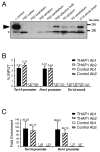Direct interaction between causative genes of DYT1 and DYT6 primary dystonia
- PMID: 20865765
- PMCID: PMC3038652
- DOI: 10.1002/ana.22138
Direct interaction between causative genes of DYT1 and DYT6 primary dystonia
Abstract
Primary dystonia is a movement disorder characterized by sustained muscle contractions and in which dystonia is the only or predominant clinical feature. TOR1A(DYT1) and the transcription factor THAP1(DYT6) are the only genes identified thus far for primary dystonia. Using electromobility shift assays and chromatin immunoprecipitation (ChIP) quantitative polymerase chain reaction (qPCR), we demonstrate a physical interaction between THAP1 and the TOR1A promoter that is abolished by pathophysiologic mutations. Our findings provide the first evidence that causative genes for primary dystonia intersect in a common pathway and raise the possibility of developing novel therapies targeting this pathway.
Figures



Comment in
-
A molecular link between dystonia 1 and dystonia 6?Ann Neurol. 2010 Oct;68(4):418-20. doi: 10.1002/ana.22183. Ann Neurol. 2010. PMID: 20976763 No abstract available.
Similar articles
-
The dystonia gene DYT1 is repressed by the transcription factor THAP1 (DYT6).Ann Neurol. 2010 Oct;68(4):554-9. doi: 10.1002/ana.22157. Ann Neurol. 2010. PMID: 20976771
-
Combined occurrence of a novel TOR1A and a THAP1 mutation in primary dystonia.Mov Disord. 2014 Jul;29(8):1079-83. doi: 10.1002/mds.25921. Epub 2014 May 23. Mov Disord. 2014. PMID: 24862462
-
Clinical and genetic evaluation of DYT1 and DYT6 primary dystonia in China.Eur J Neurol. 2011 Mar;18(3):497-503. doi: 10.1111/j.1468-1331.2010.03192.x. Epub 2010 Sep 6. Eur J Neurol. 2011. PMID: 20825472
-
Inherited isolated dystonia: clinical genetics and gene function.Neurotherapeutics. 2014 Oct;11(4):807-16. doi: 10.1007/s13311-014-0297-7. Neurotherapeutics. 2014. PMID: 25155315 Free PMC article. Review.
-
Review: genetics and neuropathology of primary pure dystonia.Neuropathol Appl Neurobiol. 2012 Oct;38(6):520-34. doi: 10.1111/j.1365-2990.2012.01298.x. Neuropathol Appl Neurobiol. 2012. PMID: 22897341 Review.
Cited by
-
Reduced Expression of GABA A Receptor Alpha2 Subunit Is Associated With Disinhibition of DYT-THAP1 Dystonia Patient-Derived Striatal Medium Spiny Neurons.Front Cell Dev Biol. 2021 May 21;9:650586. doi: 10.3389/fcell.2021.650586. eCollection 2021. Front Cell Dev Biol. 2021. PMID: 34095114 Free PMC article.
-
Identifying the genetic components underlying the pathophysiology of movement disorders.Appl Clin Genet. 2011 Jun 23;4:81-92. doi: 10.2147/TACG.S7333. Print 2011. Appl Clin Genet. 2011. PMID: 23776369 Free PMC article.
-
Update on pediatric dystonias: etiology, epidemiology, and management.Degener Neurol Neuromuscul Dis. 2012 Apr 11;2:29-41. doi: 10.2147/DNND.S16082. eCollection 2012. Degener Neurol Neuromuscul Dis. 2012. PMID: 30890876 Free PMC article. Review.
-
A high-penetrance form of late-onset torsion dystonia maps to a novel locus (DYT21) on chromosome 2q14.3-q21.3.Neurogenetics. 2011 May;12(2):137-43. doi: 10.1007/s10048-011-0274-9. Epub 2011 Feb 8. Neurogenetics. 2011. PMID: 21301909
-
Dimerization of the DYT6 dystonia protein, THAP1, requires residues within the coiled-coil domain.J Neurochem. 2011 Sep;118(6):1087-100. doi: 10.1111/j.1471-4159.2011.07386.x. Epub 2011 Aug 8. J Neurochem. 2011. PMID: 21752024 Free PMC article.
References
-
- Fuchs T, Gavarini S, Saunders-Pullman R, et al. Mutations in the THAP1 gene are responsible for DYT6 primary torsion dystonia. Nat Genet. 2009;41:286–288. - PubMed
-
- Djarmati A, Schneider SA, Lohmann K, et al. Mutations in THAP1 (DYT6) and generalised dystonia with prominent spasmodic dysphonia: a genetic screening study. Lancet Neurol. 2009;8:447–452. - PubMed
Publication types
MeSH terms
Substances
Grants and funding
LinkOut - more resources
Full Text Sources
Other Literature Sources

